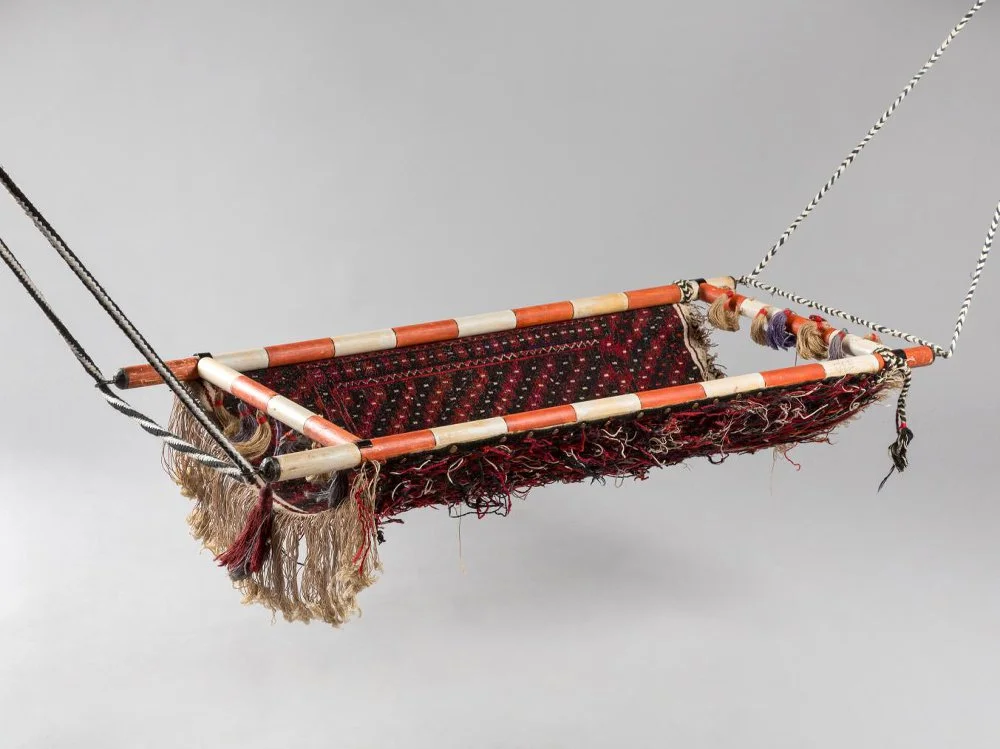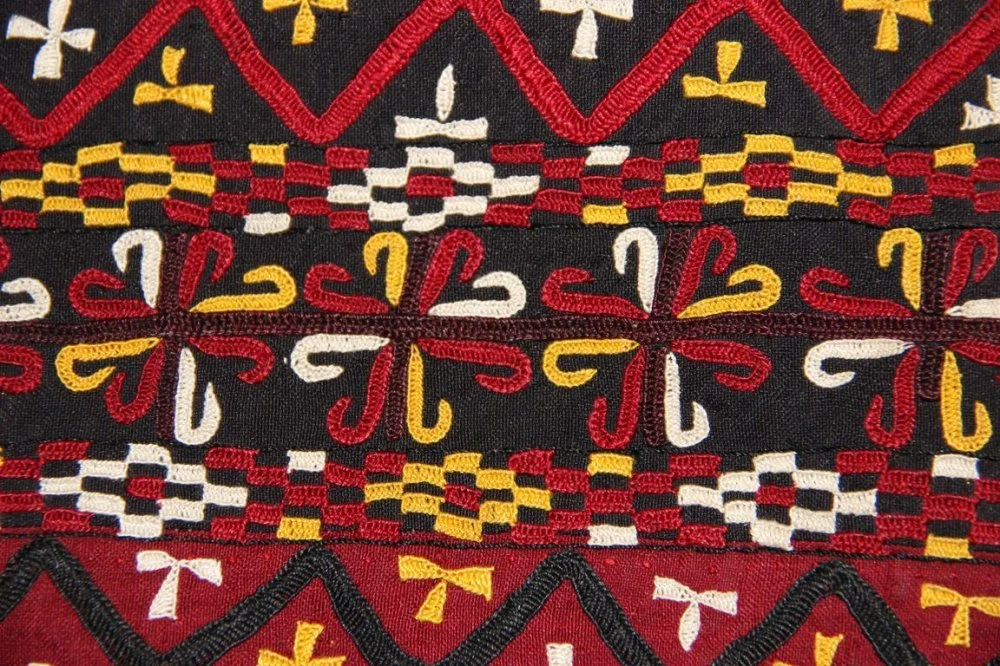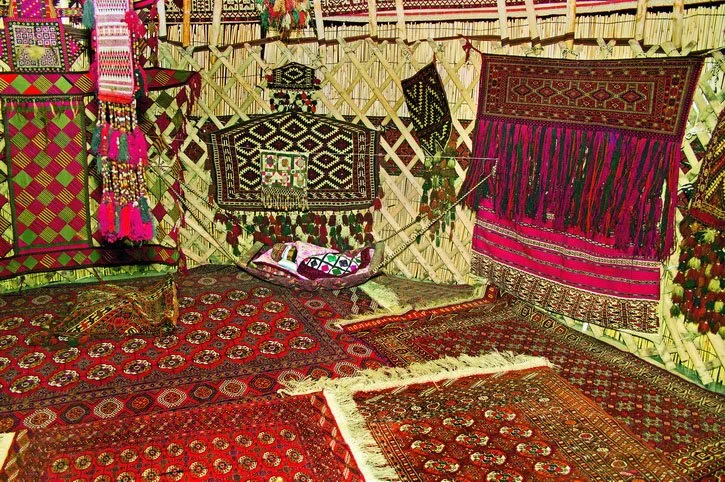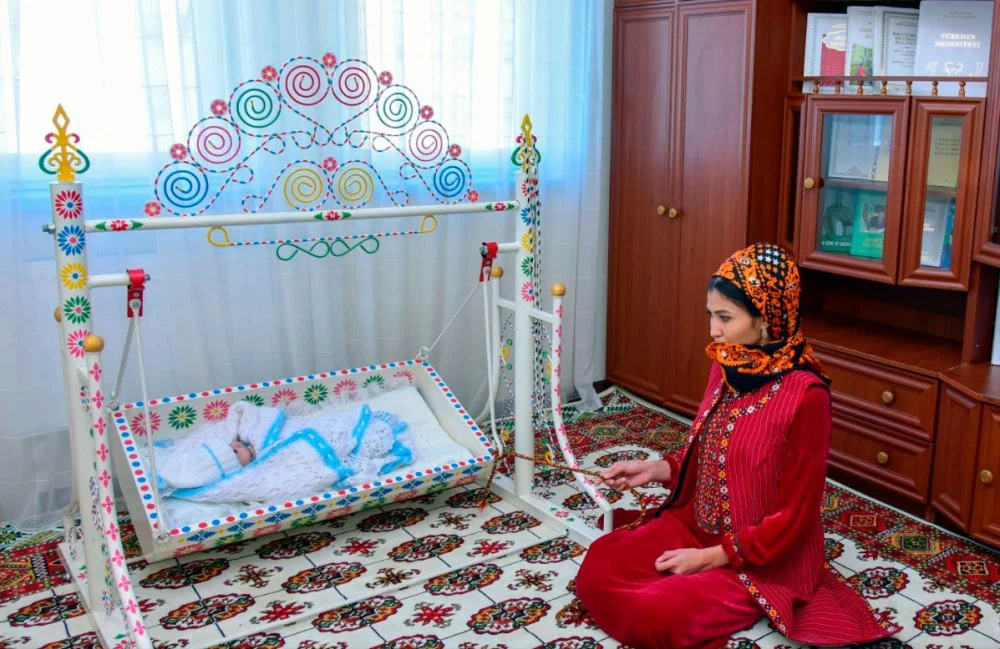Sallanchak
How do Turkmens protect babies' sleep?

The Tekinets family sitting on the carpet in front of the yurt. Photo by S. M. Prokudin-Gorsky (1911)/Alamy
A sallanchak is a traditional Turkmen cradle that is in use even today. Initially, it was simply a small, woolen napless rug that was attached to wooden sticks and suspended on thick colorful cords to the walls of a yurt. Today, the structure of a sallanchak has undergone many changes, although in many regions in Central Asia, they are still made according to ancient rules.
The sallanchak has always been an especially revered object for the Turkmen people, serving not only a practical purpose but also a mystical one. The making of a sallanchak would only begin on a special, ‘auspicious’ day. The cradle itself could become lucky—a sallanchak used by a child who grew up strong and healthy would be passed down through generations, and several generations could be rocked in it. ‘Unlucky’ cradles belonging to deceased or sick children were burned. Rocking an empty cradle was considered a very bad omen, and according to some, it could lead to childhood illnesses or even the end of the family line.

Children's cradle "sallanchak".Turkmen SSR, Krasnovodsk region, village of Kum-Dagh. 1980s/Russian Ethnographic Museum
The sallanchak kilim rug was woven specifically for the expected newborn, and all the patterns on it were meant to be talismans. The person tasked with weaving this rug was usually the pregnant woman’s mother-in-law. Occasionally, it was also woven by the elder daughter-in-law or the expecting mother herself. The sallanchak’s protective function primarily relied on talismanic patterns and their selection and composition. All ornaments in Turkmen carpets are inherently sacred, and the most recognizable Turkmen motifs are the ‘göl’ medallions. These represent ancient solar symbols, water signs, earth symbols, and sacred plants. Plant ornaments, such as gül (flower) and kızıl gül (red flower), hold strong protective significance as they are believed to bestow beauty upon the infant. Patterns like islimi and pudak, which is an offshoot or a branch, are believed to bring strong health.

Samples of Turkmen embroidery/turkmenportal.com
Frequently, göls would represent the change of the seasons or the night sky, for example when using elements like the ay for the moon and the ýulduz for the stars. Zoomorphic motifs would also often be found in ornaments, including the it topan or gudjuk izy for a dog's paw or a puppy, the jylan izy, which represents a snake's trail, or the dyrnak, used to depict a bird's claws. All these creatures were meant to guard the infant and ward off evil spirits. The symbol goçak, which looks like a curl, symbolizes the horn of a mountain ram and has very widespread use in many Turkmen ornaments. The mountain ram is a powerful totemic animal, and this symbol is meant to protect and energize.
In Turkmen ornamental art, special importance is given to the colors of the pattern, with each being assigned a specific role. And so, red signifies wealth, blue nobility, yellow serves as a talisman, while dark burgundy and brown symbolize fertility and abundance. It's not surprising then that sallanchaks were always so vibrant as every mother or grandmother tried to incorporate as many good wishes and symbols into this rug as possible.

Samples of Turkmen embroidery/turkmenportal.com
In Turkmen ornamental art, special importance is given to the colors of the pattern, with each being assigned a specific role. And so, red signifies wealth, blue nobility, yellow serves as a talisman, while dark burgundy and brown symbolize fertility and abundance. It's not surprising then that sallanchaks were always so vibrant as every mother or grandmother tried to incorporate as many good wishes and symbols into this rug as possible.
The colorful cord, known as alla-jip or alladzha, with which a child’s mother or grandmother rocked the cradle, would always have a special thick protective thread made of coarse camel wool woven into it. This was done to ensure that any small malevolent spirit, with its phantom body, attempting to climb into the cradle would be pricked by the stiff fibers and would retreat in fear. The combination of black and white in the cord served to protect the child from the evil eye.
To ward off evil, one would also tuck a piece of bread and some metallic objects under the baby's pillow. Metal and bread were considered powerful amulets as metal was meant to shield the child from hostile supernatural forces, while bread, according to superstition, induced peaceful sleep and prevented nightmares. Additional amulets, such as beads, often in black and white, silver rattles, and bird feathers, were also hung around the cradle.

The interior of the Turkmen yurt and sallanchak/turkmen.ru
Turkmen mothers, while rocking the cradle, sing lullabies called hüwdi to their children, with a chorus that goes ‘huvva-huv, heyya-hey’, from which the name of the melody originated. This hüwdi mentions the sallanchak:
Allan-allan alaýyn,
Sallançaga salaýyn,
Saňa gelen belany
Daga, daşa ýollaýyni

Turkmen embroidery/turkmenportal.com
Nowadays, sallanchaks can be seen in many Turkmen homes, but they often look different from the ones used in the nineteenth century. Most Turkmen people have moved from yurts to modern houses, and sallanchaks are less frequently attached to the walls as it is inconvenient. These days, the sallanchak has got a special hanging structure, which is typically a white-painted metal frame, incorporating solar and plant protective symbols in its design. The mattress, usually now white, is often adorned with bright ornaments, styled flowers and symbols of the sun and earth (circles, squares, and triangles).

Modern sallanchak/turkmenistan.gov.tm
The colorful cord used to rock the cradle is still used with the modern sallanchak, and it may now be multicolored rather than strictly black and white.
Turkmen families still continue the tradition of gift sallanchaks to newborns and their families, but unfortunately, most of these cradles are now produced in factories. The ancient craft is gradually becoming history, and antique carpet cribs are easier to find in ethnographic museums than in modern multistoried homes.
What to read
Beresneva, Lyudmila. 2006. ‘Magic of the Turkmen Carpet’. Antiques, Art Objects, and Collectibles. No. 39



